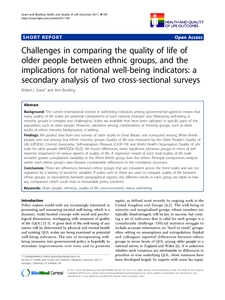Grant, RL; Bowling, A
(2011)
Challenges in comparing the quality of life of older people between ethnic groups, and the implications for national well-being indicators: a secondary analysis of two cross-sectional surveys.
HEALTH AND QUALITY OF LIFE OUTCOMES, 9 (109).
ISSN 1477-7525
https://doi.org/10.1186/1477-7525-9-109
SGUL Authors: Grant, Robert Lawerance
![[img]](https://openaccess.sgul.ac.uk/101621/1.hassmallThumbnailVersion/1477-7525-9-109.pdf)  Preview |
|
["document_typename_application/pdf; charset=binary" not defined]
Published Version
Download (327kB)
| Preview
|
Abstract
BACKGROUND: The current international interest in well-being indicators among governmental agencies means that many quality of life scales are potential components of such national indicator sets. Measuring well-being in minority groups is complex and challenging. Scales are available that have been validated in specific parts of the population, such as older people. However, validation among combinations of minority groups, such as older adults of ethnic minority backgrounds, is lacking.
FINDINGS: We pooled data from two surveys of older adults in Great Britain: one conducted among White British people, and one among four ethnic minority groups. Quality of life was measured by the Older People's Quality of Life (OPQOL); Control, Autonomy, Self-realisation, Pleasure (CASP-19); and World Health Organization Quality of Life scale for older people (WHOQOL-OLD). We found differences, some significant, between groups in terms of self-reported importance of various aspects of quality of life. A regression model of each total quality of life scale revealed greater unexplained variability in the White British group than the others. Principal components analysis within each ethnic group's data showed considerable differences in the correlation structures.
CONCLUSIONS: There are differences between ethnic groups that are consistent across the three scales and are not explained by a battery of predictor variables. If scales such as these are used to compare quality of life between ethnic groups, or equivalently between geographical regions, the different results in each group are liable to bias any comparison which could lead to inequitable policy decisions.
| Item Type: |
Article
|
| Additional Information: |
© 2011 Grant and Bowling; licensee BioMed Central Ltd. This is an Open Access article distributed under the terms of the Creative Commons Attribution License (http://creativecommons.org/licenses/by/2.0), which permits unrestricted use, distribution, and reproduction in any medium, provided the original work is properly cited. |
| Keywords: |
Aged, Aged, 80 and over, Ethnic Groups, Female, Great Britain, Humans, Male, Quality Indicators, Health Care, Quality of Life, Questionnaires, Regression Analysis, Self Disclosure, Older people, ethnicity, well-being, socio-economic status, Science & Technology, Life Sciences & Biomedicine, Health Care Sciences & Services, Health Policy & Services |
| Journal or Publication Title: |
HEALTH AND QUALITY OF LIFE OUTCOMES |
| ISSN: |
1477-7525 |
| Dates: |
| Date | Event |
|---|
| 5 December 2011 | Published |
|
| Web of Science ID: |
WOS:000299049800001 |
  |
Download EPMC Full text (PDF)
|
 |
Download EPMC Full text (HTML)
|
| URI: |
https://openaccess.sgul.ac.uk/id/eprint/101621 |
| Publisher's version: |
https://doi.org/10.1186/1477-7525-9-109 |
Statistics
Item downloaded times since 27 Jun 2013.
Actions (login required)
 |
Edit Item |



